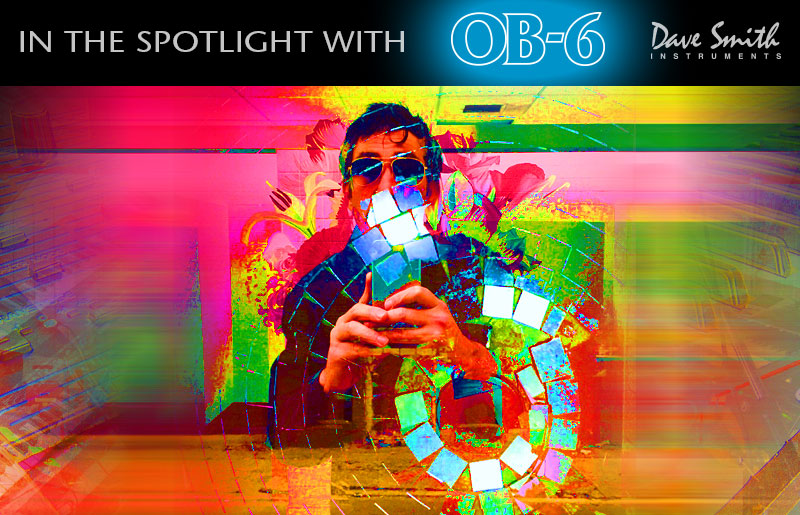
Sunshine Jones is an electronic musician from San Francisco, California. He is a production machine that seems to be in constant motion. Hand made releases, full fledged vinyl releases, customized eurorack modules, hand built synthesizers, tutorial videos, consultations with manufacturers, beta testing, and non-stop encouragement for people who are curious about getting their heads together about playing live electronic music.
From 1991 – 2005 he was one half of Dubtribe Sound System. While Dubtribe continues to perform periodically at festivals and special engagements, Sunshine travels the world solo these days playing 100% live improvisational electronic music, and hosting the Play Live! seminars where he discusses how to play live music as an electronic artist, and what it means. His aim is to encourage people to get started regardless of what gear they have. But his focus always comes back to doing it without a computer, without a tablet, and without a phone. The idea is to play live, and get into the moment. He is also a well-loved, and well-traveled DJ.
He has produced, recorded and released music on Jive, BMG, Universal, Defected, King Street, Oh! Stockholm, Cosmic Disco, Treehouse Muzique, and dozens of other indie labels. He also operates the San Francisco-based record label, The Urgency Of Change. For more information about Sunshine Jones, visit his website.
We chatted with him about how he’s using the OB-6.
What made you choose the OB-6?
“I was at a modular meetup in San Francisco, where I got to put my hands on the OB-6 Keyboard. I slipped the headphones on and played a few notes and pretty much started crying. It was too good to be true. Just exactly right. I was drawn to the OB-6 because I am a huge fan of both Tom and Dave. Their collaborative effort with analog circuitry and an SEM filter inside just had to be mine. I coveted it for more than a year, as I’m constantly on tour, and had to wait for the module version to come out before I could seriously consider adding it to my spaceship.“
How are you using it?
“I’m using the OB-6 in a few different ways. First and foremost, it is the main poly synth in my live performances. I rely on it completely for real time control over pads, strings, washes and bass doubling for almost every one of my live songs. But I’ve also been enjoying clocking the sequencer from an external source and playing with time to create accidental compositions. It’s just beautiful.”
What’s one of your favorite things about it?
“I could go on and on about a lot of the things on the OB-6 that I love. The sequencer, the control inputs, the filter, the killer addition of the x-mod functions, the wonderful way that the panel is laid out, all make it seem so deceptively simple, right there in front of me, even in the dark of a performance. But really it’s the sound, the sound, the sound. It just sounds fantastic. It’s the truth and I really love that about it.”
What does it give you that other instruments don’t?
“That’s a really good question. I think that initially I was coming from road synths, which were meant to be breakable in a way. Smaller, and more portable synthesizers which, if the airline lost them, or the humidity got to them, I wouldn’t be totally demolished. And so the OB-6 was my first serious step into a more precious and more mature synthesizer, specifically for touring. Initially I was surprised that some of the lower-fidelity synths cut through in a big club system a little more than the OB-6 did. So that brought me into the synth to work harder and spend more time per song with it. I have come to revel in the nuances, and the subtlety of the OB-6. It’s really its own thing. It’s not just another poly synth. It has needs, and character, and a feeling, and that’s a wonderful thing.”
Any interesting tricks or techniques you’d like to share?
“I call this ‘clock advance per step.’ Get to the OB-6 and press the sequencer and play the individual notes of a few chords you love. Now get a clock source, or a drum machine you love and send a trigger output into the clock input for the sequencer. On the drum machine, or clock source, play with the time. Don’t leave it as a basic 16-beat time keeper, but rather let 5 clock pulses come through. Listen to your melody unfold, and start playing with the filter, the envelope and the effects. Let a whole world unravel around you.
This next one’s too easy. But I have a few songs with a very lush and pretty undertone in them. I program the OB-6 to enter sweetly, with some low pass filter dampening the sound of the pad. Rather than sending a CC message or programming an LFO to automatically raise and lower the filter frequency, I wait for just the right moment and then raise up the filter envelope. It’s like turning on a light in the club. It’s a really lovely effect.”
MORE ABOUT THE OB-6
For more information, check out the OB-6 product page here.
Find your local dealer for OB-6 pricing here.
If you’re using your DSI gear in interesting ways, tell us about it. Contact us at .
